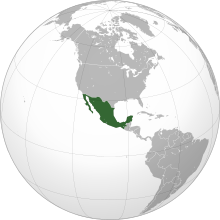Mexico
Courtesy: Wikipedia
| United Mexican States | ||||||
|---|---|---|---|---|---|---|
| ||||||
| Anthem: "Himno Nacional Mexicano" Mexican National Anthem | ||||||
| National seal: Seal of the United Mexican States | ||||||
| Capital (and largest city) | Mexico City 19°03′N 99°22′W / 19.05°N 99.367°W | |||||
| Official language(s) | Spanish [1] | |||||
| Recognised regional languages | 62 Indigenous Amerindian languages[3] | |||||
| Demonym | Mexican | |||||
| Government | Federal Republic[4] | |||||
| - | President | Felipe Calderón (PAN) | ||||
| - | Secretary of the Interior | José Francisco Blake Mora | ||||
| - | Supreme Court President | Guillermo Ortiz Mayagoitia | ||||
| Legislature | Congress | |||||
| - | Upper House | Senate | ||||
| - | Lower House | Chamber of Deputies | ||||
| Independence | from Spain | |||||
| - | Declared | September 16, 1810 | ||||
| - | Recognized | September 27, 1821 | ||||
| Area | ||||||
| - | Total | 1,972,550 km2 (15th) 761,606 sq mi | ||||
| - | Water (%) | 2.5 | ||||
| Population | ||||||
| - | July 2009 estimate | 111,211,789[5] (11th) | ||||
| - | 2005 census | 103,263,388 | ||||
| - | Density | 55/km2 (142nd) 142/sq mi | ||||
| GDP (PPP) | 2010 estimate | |||||
| - | Total | $1.541 trillion[6] (11) | ||||
| - | Per capita | $14,495[6] (45th) | ||||
| GDP (nominal) | 2010 estimate | |||||
| - | Total | $1.085 trillion[6] (13) | ||||
| - | Per capita | $10,211[6] (46th) | ||||
| Gini (2008) | ▼ 46.1[7] (high) | |||||
| HDI (2007) | ▲ 0.854[8] (high) (53rd) | |||||
| Currency | Peso (MXN) | |||||
| Time zone | Official Mexican Timezones (UTC-8 to −6) | |||||
| - | Summer (DST) | varies (UTC-7 to −5) | ||||
| Drives on the | right | |||||
| Internet TLD | .mx | |||||
| Calling code | +52 | |||||
In Pre-Columbian Mesoamerica many cultures matured into advanced civilizations such as the Olmec, the Toltec, the Teotihuacan, the Zapotec, the Maya and the Aztec before the first contact with Europeans. In 1521, Spain conquered and colonized the territory, which was administered as the viceroyalty of New Spain which would eventually become Mexico as the colony gained independence in 1821. The post-independence period was characterized by economic instability, territorial secession and civil war, including foreign intervention, two empires and two long domestic dictatorships. The latter led to the Mexican Revolution in 1910, which culminated with the promulgation of the 1917 Constitution and the emergence of the country's current political system. Elections held in July 2000 marked the first time that an opposition party won the presidency from the Institutional Revolutionary Party (Spanish: Partido Revolucionario Institucional, PRI).
As a regional power,[14][15] and since 1994 the first Latin American member of the Organisation for Economic Co-operation and Development (OECD), Mexico is firmly established as an upper middle-income country,[16] and is considered a newly industrialized country[17][18][19][20] and an emerging power.[21] It has the 13th largest nominal GDP and the 11th largest by purchasing power parity. The economy is strongly linked to those of its North American Free Trade Agreement (NAFTA) partners, especially the United States,[22][23] as well as tourism, being the world's tenth most visited country with over 21.4 million international arrivals.[24] Mexico boasts a long tradition in the arts, renowned cuisine, and culture, and it ranks fifth in the world and first in the Americas on the list of UNESCO World Heritage Sites with 31.[25][26][27]



